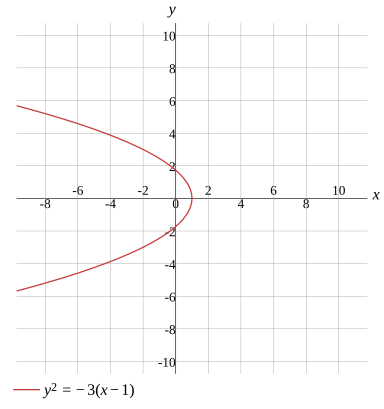Question
Identify the conic
Find the standard equation of the parabola
Find the vertex of the parabola
Find the focus of the parabola
Load more

y2=−3(x−1)
Evaluate
1×y2=−3(x−1)
Solution
y2=−3(x−1)
Show Solution

Solve the equation
Solve for x
Solve for y
x=3−y2+3
Evaluate
1×y2=−3(x−1)
Any expression multiplied by 1 remains the same
y2=−3(x−1)
Swap the sides of the equation
−3(x−1)=y2
Change the sign
3(x−1)=−y2
Divide both sides
33(x−1)=3−y2
Divide the numbers
x−1=3−y2
Use b−a=−ba=−ba to rewrite the fraction
x−1=−3y2
Move the constant to the right side
x=−3y2+1
Solution
More Steps


Evaluate
−3y2+1
Reduce fractions to a common denominator
−3y2+33
Write all numerators above the common denominator
3−y2+3
x=3−y2+3
Show Solution

Testing for symmetry
Testing for symmetry about the origin
Testing for symmetry about the x-axis
Testing for symmetry about the y-axis
Not symmetry with respect to the origin
Evaluate
1y2=−3(x−1)
Simplify the expression
y2=−3(x−1)
To test if the graph of 1y2=−3(x−1) is symmetry with respect to the origin,substitute -x for x and -y for y
(−y)2=−3(−x−1)
Evaluate
y2=−3(−x−1)
Solution
Not symmetry with respect to the origin
Show Solution

Find the first derivative
Find the derivative with respect to x
Find the derivative with respect to y
dxdy=−2y3
Calculate
1y2=−3(x−1)
Simplify the expression
y2=−3(x−1)
Take the derivative of both sides
dxd(y2)=dxd(−3(x−1))
Calculate the derivative
More Steps


Evaluate
dxd(y2)
Use differentiation rules
dyd(y2)×dxdy
Use dxdxn=nxn−1 to find derivative
2ydxdy
2ydxdy=dxd(−3(x−1))
Calculate the derivative
More Steps


Evaluate
dxd(−3(x−1))
Simplify
−3×dxd(x−1)
Rewrite the expression
−3×1
Any expression multiplied by 1 remains the same
−3
2ydxdy=−3
Divide both sides
2y2ydxdy=2y−3
Divide the numbers
dxdy=2y−3
Solution
dxdy=−2y3
Show Solution

Find the second derivative
Find the second derivative with respect to x
Find the second derivative with respect to y
dx2d2y=−4y39
Calculate
1y2=−3(x−1)
Simplify the expression
y2=−3(x−1)
Take the derivative of both sides
dxd(y2)=dxd(−3(x−1))
Calculate the derivative
More Steps


Evaluate
dxd(y2)
Use differentiation rules
dyd(y2)×dxdy
Use dxdxn=nxn−1 to find derivative
2ydxdy
2ydxdy=dxd(−3(x−1))
Calculate the derivative
More Steps


Evaluate
dxd(−3(x−1))
Simplify
−3×dxd(x−1)
Rewrite the expression
−3×1
Any expression multiplied by 1 remains the same
−3
2ydxdy=−3
Divide both sides
2y2ydxdy=2y−3
Divide the numbers
dxdy=2y−3
Use b−a=−ba=−ba to rewrite the fraction
dxdy=−2y3
Take the derivative of both sides
dxd(dxdy)=dxd(−2y3)
Calculate the derivative
dx2d2y=dxd(−2y3)
Use differentiation rules
dx2d2y=−23×dxd(y1)
Rewrite the expression in exponential form
dx2d2y=−23×dxd(y−1)
Calculate the derivative
More Steps


Evaluate
dxd(y−1)
Use differentiation rules
dyd(y−1)×dxdy
Use dxdxn=nxn−1 to find derivative
−y−2dxdy
dx2d2y=−23(−y−2dxdy)
Rewrite the expression
dx2d2y=−23(−y2dxdy)
Calculate
dx2d2y=2y23dxdy
Use equation dxdy=−2y3 to substitute
dx2d2y=2y23(−2y3)
Solution
More Steps


Calculate
2y23(−2y3)
Multiply the terms
More Steps


Evaluate
3(−2y3)
Multiplying or dividing an odd number of negative terms equals a negative
−3×2y3
Multiply the terms
−2y3×3
Multiply the terms
−2y9
2y2−2y9
Multiply by the reciprocal
−2y9×2y21
Multiply the terms
−2y×2y29
Multiply the terms
More Steps


Evaluate
2y×2y2
Multiply the numbers
4y×y2
Multiply the terms
4y3
−4y39
dx2d2y=−4y39
Show Solution

Rewrite the equation
r=2sin2(θ)−3cos(θ)+9+3sin2(θ)r=−2sin2(θ)3cos(θ)+9+3sin2(θ)
Evaluate
1×y2=−3(x−1)
Any expression multiplied by 1 remains the same
y2=−3(x−1)
Move the expression to the left side
y2+3x=3
To convert the equation to polar coordinates,substitute x for rcos(θ) and y for rsin(θ)
(sin(θ)×r)2+3cos(θ)×r=3
Factor the expression
sin2(θ)×r2+3cos(θ)×r=3
Subtract the terms
sin2(θ)×r2+3cos(θ)×r−3=3−3
Evaluate
sin2(θ)×r2+3cos(θ)×r−3=0
Solve using the quadratic formula
r=2sin2(θ)−3cos(θ)±(3cos(θ))2−4sin2(θ)(−3)
Simplify
r=2sin2(θ)−3cos(θ)±9+3sin2(θ)
Separate the equation into 2 possible cases
r=2sin2(θ)−3cos(θ)+9+3sin2(θ)r=2sin2(θ)−3cos(θ)−9+3sin2(θ)
Solution
r=2sin2(θ)−3cos(θ)+9+3sin2(θ)r=−2sin2(θ)3cos(θ)+9+3sin2(θ)
Show Solution

Graph
